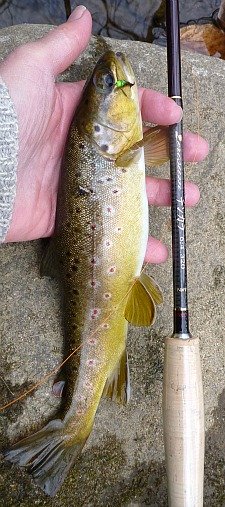Lillian Knot
To Knot or Not to Knot?
American tenkara anglers take the lillian knot for granted. I guess maybe it is like the cork grip - they just assume it has to be there. Well, it doesn't have to be there. What's more, there is a good reason for it not to be there. To knot or not to knot? I vote not.
I recently received an email from a new customer whose friend had put a drop of glue on the lillian knot of his new tenkara rod to make sure it wouldn't come undone. My customer wondered if he should do the same.
I suggested he not glue his lillian knot. I didn't go so far as to recommend he unknot his knot, but I should have. I do specifically recommend that customers who use level lines to not put a knot in the lilian.
Daiwa does not ship their rods with knots in the lillians - and neither does Shimano, Gamakatsu, Nissin, Suntech or Shimotsuke.

What's more, the Daiwa rods intended for level lines come with a lillian that is thick enough, and short enough, that it is extremely hard to put a knot in it. For the first few I sold, I tied the lillian knot myself to save the customer the risk of breaking a fragile tip trying to do it. And once the knot is in it, the lillian, which was short to begin with was really short - almost too short to put through the loop in the level line attachment knot (arbor knot) twice.
At first I really wondered why an obviously high quality, expensive rod didn't have a lillian that was long enough. I mean why try to save a couple yen by making the lillian a couple centimeters too short? Then it dawned on me that they've been doing this for a pretty long time, in the very home of tenkara. They probably know what they are doing. Then I recalled that Dr. Ishigaki did not have a lillian knot when I saw his rod in the Catskills.
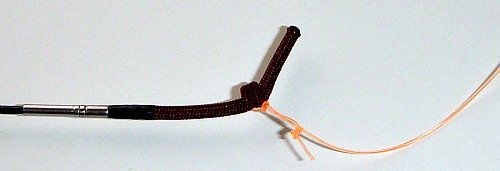
I stopped tying knots in the lillians of the Daiwa level line rods. Then I untied all the knots in all the lillians of all my rods (at least all the ones I ever use). Then I stopped tying knots in the lillians of all the rods I sell. I suspect most buyers, without ever thinking about it, tie in the lillian knot when they get the rod, but I've started suggesting to buyers of the Daiwa level line rods in particular than they not put a knot in the lillian, and furthermore (for at least a few) I've strongly cautioned that they not let well meaning fishing partners or guides do it for them, either.
If you fish with level lines you absolutely, positively do not need a knot in the end of your lillian. The line to lillian attachment method I outline on my level line page is secure enough that the knot should never slip - at all. If you are going to fish with a line that requires a girth hitch for attachment to the rod, I suspect you would be safer with the knot than without. The girth hitch does slip and to be safe you should probably have a knot.
I have now fished tenkara for seven full seasons. I have had one line come off that was attached with an arbor knot and one line come off that was attached with a girth hitch. Since I almost always fish with a level line and arbor knot, if it wasn't a secure attachment, it would have come off much more frequently than the girth hitch.
All the above was to explain why you don't need a knot. Now I'll explain why you don't want one. After every use, I fully disassemble every rod I've fished with so that it can thoroughly dry. Just a quick wipe with a paper towel or Kleenex will not only help dry but also help clean the rod sections. Perhaps if I lived in an arid state it wouldn't be necessary. In a humid state it is. I don't know how the rods get wet inside, but they do (possibly from water dripping off the line when it occasionally wraps around the rod), or if the grip or tip inadvertently gets into the stream when unhooking a fish.
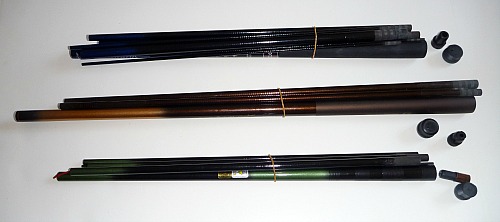
In any event, if a rod is used repeatedly and not allowed to dry, in a humid climate you will get bacterial growth and it will start to smell after a while. I've had rods that I lent to other anglers come back with an odor. I suspect that not allowing the rods to dry between uses also increases the chances for the sections sticking together when trying to collapse the rod.
I have also learned of rods from different
manufacturers that had the finish ruined from being put away wet. The photo below shows an example of one such rod.
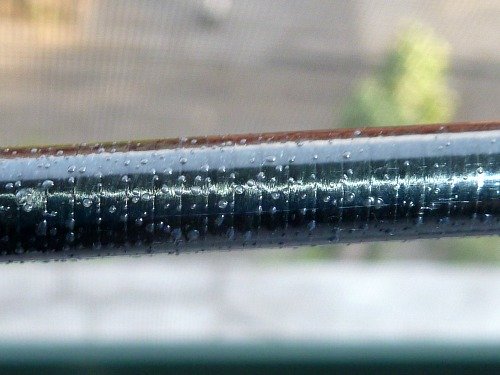
If you have a knot in the end of the lillian, you cannot separate the tip section from the second section. On one of my rods, the knot was large enough that I couldn't separate the top three sections. Given that the tip is most likely to stick - or at least most likely to be broken if it does stick, I think wiping down each section and allow the rod sections to dry thoroughly is very good insurance against breakage. Of course, you have to put the rods in a safe place - somewhere that they won't have something heavy placed on top of them inadvertently and where they won't get knocked to the floor by accident. Needless to say, that rod no longer has a knot in the lillian.
Taking the rods apart and wiping them down, and then reassembling them the next morning has become a bit of a ritual end of a fishing day for me. It takes almost no time and makes sure the rods are well cared for.
TenkaraBum Home > Tenkara Rods > Lillian Knot
“The bitterness of poor quality remains long after the sweetness of low price is forgotten” - Benjamin Franklin
"Be sure in casting, that your fly fall first into the water, for if the line fall first, it scares or frightens the fish..." -
Col. Robert Venables 1662
As age slows my pace, I will become more like the heron.
We've all had situations where seriously chewed up flies kept catching fish after fish after fish. It is no sin to tie flies that come off the vise looking seriously chewed up.
Warning:
The hooks are sharp.
The coffee's hot.
The fish are slippery when wet.
Beware of the Dogma
Seriously, all the hooks sold on TenkaraBum.com, whether packaged as loose hooks or incorporated into flies, are dangerously sharp. Some have barbs, which make removal from skin, eyes or clothing difficult. Wear eye protection. Wear a broad-brimmed hat. If you fish with or around children, bend down all hook barbs and make sure the children wear eye protection and broad-brimmed hats. Be aware of your back cast so no one gets hooked.
Also, all the rods sold on TenkaraBum.com will conduct electricity. Do not, under any circumstances, fish during a thunder storm. Consider any fishing rod to be a lightning rod! Fishing rods can and do get hit by lightning!
What's in stock?
Suntech Tenkarakyo 40F Tenkara Rods
Daiwa Keiryu-X 39
Nissin Oni Tenkara Line
Coming Soon
January
Kurenai II AR 30F
Kurenai II AR 33F
Kurenai II AR 39F
Nissin Oni Line size 3
Nissin Oni Line size 3.5
TenkaraBum 33
TenkaraBum 36
TenkaraBum 40
Medium Rod Case
Furaibo TF39
Furaibo TF39TA
Latest Pages
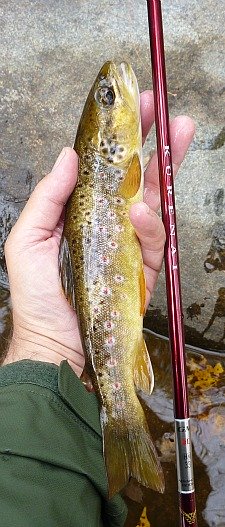 Suntech Kurenai
Suntech KurenaiIf you enjoy spin fishing or baitcasting please visit my sister site Finesse-Fishing.com.



